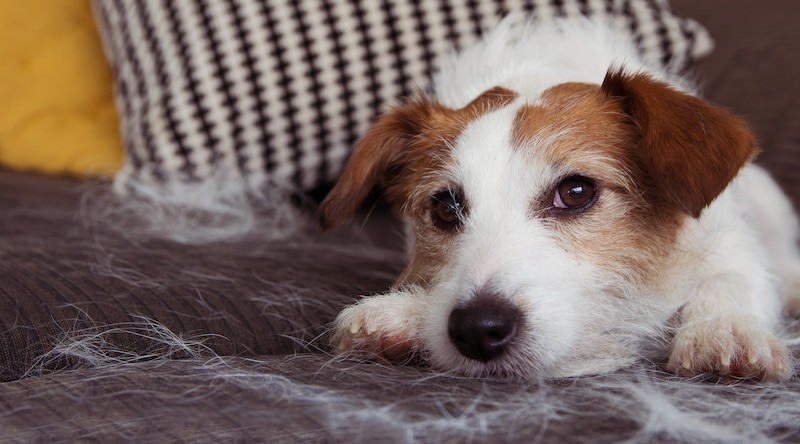Some dogs are known for being particularly heavy or light shedders. The difference is in the degree of difficulty of maintenance. Running a brush over a short-coated shedding breed and bathing her is easy, and most people do that at home.
Bathing and stretch drying curly hair and trimming a Poodle requires more skill, tools, and time—and usually a professional groomer. The trade-off of having a dog that doesn’t shed heavily is that it may need to go to a groomer or be groomed at home thoroughly and frequently.
Heavy Shedding Dogs
Labrador Retrievers, Rottweilers, and German Shepherds are dogs with short coats that you might not think would be heavy shedders, but they are. These dogs shed short hair all year long, and they shed undercoat seasonally as well. You need to brush these breeds at least weekly to keep down the shedding hair.
What can you do to stop my dog from shedding so much?
First, look at your dog’s diet. Diet plays an important part in the health of skin and hair. If your dog isn’t getting enough Omega 3 and 6 fatty acids in his diet, his skin will be drier, and dry skin tends to shed more hair. Many “lite,” “reducing,” or “senior” diets have a very restricted fat content that could predispose the dog to dry skin and a coarse, brittle coat.
Next, make sure your dog is groomed routinely. Regular bathing, brushing, and carding helps remove dead and dying hair from the dog.
Light Shedding Dogs
Most drop-coated and curly-coated breeds fit this category, as well as some Terriers. These dogs require grooming on a regular basis, as well as maintenance between grooms of brushing and combing to prevent mats. These coats are more hypoallergenic than the heavier shedding breeds due to a longer growth cycle and less dander.
There are no non shedding breeds. All dogs shed, but some shed less often. If you don’t see shedding hair from your Poodle tumbling through your house, it isn’t because she doesn’t shed hair; it’s because it is caught up in the curls and won’t just fall out all over the place on its own. You have to comb it out or she will end up with a matted coat.
Special Cases
Certain conditions may cause your dog’s hair to change. Just because your dog is a certain breed doesn’t necessarily mean his hair will conform to the breed standard.
Medical Issues
If your dog is shedding unusual amounts of hair at an unusual time of year, she may have an undiagnosed health problem. If your dog is losing enough coat that you can clearly see his skin, you need to take your dog to the vet to have him evaluated.
There are many causes of hair loss. Conditions such as mange, allergies, or fleas can cause hair loss, as well as hypothyroidism and Cushing’s disease. Don’t hesitate to seek out the cause of the problem.
Dogs that undergo anesthesia will often blow their coat a few weeks after. This hair will grow back, but it’s a heavy shed. In addition, some very nervous dogs shed more hair due to their inborn fight-or-flight sense. When an animal in the wild is grabbed by another (for lunch), it instantly sheds the portion of hair that is traumatized or grabbed to get away. The hunter ends up with a fur sandwich instead of meat. Cats also do this when frightened.
Hormones
Hormones also play a special role in the shedding of hair. Intact females and males generally have a lighter undercoat than their spayed and neutered counterparts. After a female’s heat cycle, she will have a heavy shedding period, in addition to the normal seasonal sheds.
A female that gives birth will undergo a very heavy shedding period after weaning the puppies due to a change in hormones. Human women often go through this hair-shedding period after giving birth to their children.
A spayed female will tend to grow a thicker undercoat, again due to a change or lack of hormones. This is known as a spay coat, and you may notice wispy hairs poking out from her coat that she never had before. It just requires a little extra brushing and carding to keep her looking good.

